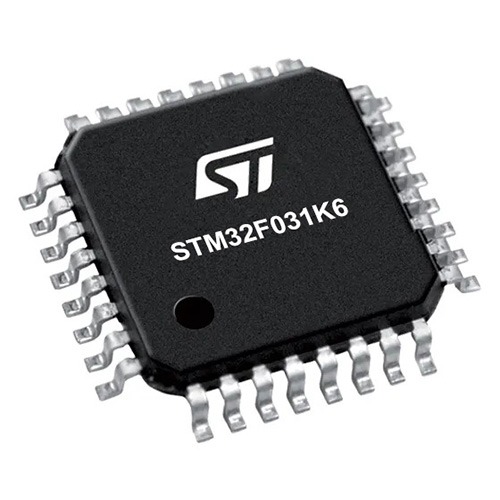通过集成先进的健康监测功能,提升您的解决方案,提供实时心率和血氧饱和度数据。
A
A
硬件概览
它是如何工作的?
Oximeter 2 Click基于ADPD144RI,这是一款高度集成的光度前端,优化用于Analog Devices的血氧饱和度光电容积描记法(PPG)检测。它结合了高效的红色和红外LED发射器,波长分别为660nm红光和880nm红外光,以及一个灵敏的4通道光电二极管和一个定制的ASIC,提供集成LED发射器和检测光电二极管之间的光隔离,以提高信噪比。它使用同步检测光脉冲以增强对环境光的拒绝,同时具有低功耗。Oximeter 2 Click设计用于超低直接光反射,具有每通道独立的AFE设置和I2C控制接口。集成的LED发射器在AFE的主动采
样周期内产生与其同步的光脉冲,AFE由一个可编程TIA、一个带通滤波器和一个积分器组成。处理后的模拟信号由14位ADC数字化,并由20位突发累加器进行累加。四个同时采样通道被矩阵化为两个独立的时间槽(每个LED波长一个)。可调节的每个样本脉冲数、累积和平均值可以应用于多个样本,以将动态范围增加到27位。Oximeter 2 Click使用标准I2C 2线接口与MCU通信,典型时钟频率为400kHz。高速I2C接口直接或通过FIFO缓冲区从输出寄存器读取数据。所有寄存器写入仅为单词,并需要16位数据。它还配有一个可编程中断线,标
记为INT并路由到mikroBUS™插座的INT引脚,简化了及时数据访问。ADPD144RI不需要特定的上电顺序,但需要1.8V的供电电压才能正常工作。因此,一个小型稳压LDO,即Analog Devices的ADP160,从3.3V mikroBUS™轨提供1.8V输出。此Click板™只能在3.3V逻辑电压水平下工作。在使用具有不同逻辑电平的MCU之前,必须进行适当的逻辑电压电平转换。此外,Click板™配备了一个包含函数和示例代码的库,可用作进一步开发的参考。
功能概述
开发板
Nucleo 32开发板搭载STM32F031K6 MCU,提供了一种经济且灵活的平台,适用于使用32引脚封装的STM32微控制器进行实验。该开发板具有Arduino™ Nano连接性,便于通过专用扩展板进行功能扩展,并且支持mbed,使其能够无缝集成在线资源。板载集成
ST-LINK/V2-1调试器/编程器,支持通过USB重新枚举,提供三种接口:虚拟串口(Virtual Com port)、大容量存储和调试端口。该开发板的电源供应灵活,可通过USB VBUS或外部电源供电。此外,还配备了三个LED指示灯(LD1用于USB通信,LD2用于电源
指示,LD3为用户可控LED)和一个复位按钮。STM32 Nucleo-32开发板支持多种集成开发环境(IDEs),如IAR™、Keil®和基于GCC的IDE(如AC6 SW4STM32),使其成为开发人员的多功能工具。

微控制器概述
MCU卡片 / MCU

建筑
ARM Cortex-M0
MCU 内存 (KB)
32
硅供应商
STMicroelectronics
引脚数
32
RAM (字节)
4096
你完善了我!
配件
Click Shield for Nucleo-32是扩展您的开发板功能的理想选择,专为STM32 Nucleo-32引脚布局设计。Click Shield for Nucleo-32提供了两个mikroBUS™插座,可以添加来自我们不断增长的Click板™系列中的任何功能。从传感器和WiFi收发器到电机控制和音频放大器,我们应有尽有。Click Shield for Nucleo-32与STM32 Nucleo-32开发板兼容,为用户提供了一种经济且灵活的方式,使用任何STM32微控制器快速创建原型,并尝试各种性能、功耗和功能的组合。STM32 Nucleo-32开发板无需任何独立的探针,因为它集成了ST-LINK/V2-1调试器/编程器,并随附STM32全面的软件HAL库和各种打包的软件示例。这个开发平台为用户提供了一种简便且通用的方式,将STM32 Nucleo-32兼容开发板与他们喜欢的Click板™结合,应用于即将开展的项目中。
使用的MCU引脚
mikroBUS™映射器
“仔细看看!”
Click board™ 原理图

一步一步来
项目组装
实时跟踪您的结果
应用程序输出
1. 应用程序输出 - 在调试模式下,“应用程序输出”窗口支持实时数据监控,直接提供执行结果的可视化。请按照提供的教程正确配置环境,以确保数据正确显示。

2. UART 终端 - 使用UART Terminal通过USB to UART converter监视数据传输,实现Click board™与开发系统之间的直接通信。请根据项目需求配置波特率和其他串行设置,以确保正常运行。有关分步设置说明,请参考提供的教程。

3. Plot 输出 - Plot功能提供了一种强大的方式来可视化实时传感器数据,使趋势分析、调试和多个数据点的对比变得更加直观。要正确设置,请按照提供的教程,其中包含使用Plot功能显示Click board™读数的分步示例。在代码中使用Plot功能时,请使用以下函数:plot(insert_graph_name, variable_name);。这是一个通用格式,用户需要将“insert_graph_name”替换为实际图表名称,并将“variable_name”替换为要显示的参数。

软件支持
库描述
该库包含 Oximeter 2 Click 驱动程序的 API。
关键功能:
oximeter2_cfg_setup- 配置对象初始化功能。oximeter2_init- 初始化功能。
开源
代码示例
完整的应用程序代码和一个现成的项目可以通过NECTO Studio包管理器直接安装到NECTO Studio。 应用程序代码也可以在MIKROE的GitHub账户中找到。
/*!
* \file main.c
* \brief Oximeter2 Click example
*
* # Description
* This application collects data from the sensor, calculates it and then logs
* the result.
*
* The demo application is composed of two sections :
*
* ## Application Init
* Initializes driver and performs the device configuration which puts Time Slot A
* and Time Slot B modes to active state.
* Before the device configuration, the SW reset will be performed, which puts
* the registers in their initial state.
*
* ## Application Task
* Application measures value of oxygen level in human's blood.
*
*
* \author MikroE Team
*
*/
// ------------------------------------------------------------------- INCLUDES
#include "board.h"
#include "log.h"
#include "oximeter2.h"
// ------------------------------------------------------------------ VARIABLES
// Oximeter 2 context instance declaration.
static oximeter2_t oximeter2;
// Logger context instance declaration.
static log_t logger;
// Result storage.
static uint32_t res_slot[ 100 ];
// ------------------------------------------------------ APPLICATION FUNCTIONS
void oximeter2_write_res ( uint32_t data_write )
{
log_printf( &logger, "%u\r\n", data_write );
}
void oximeter2_logs_results( void )
{
uint8_t final_result;
oximeter2_read_data( &oximeter2, &res_slot[ 0 ] );
log_printf( &logger, "Average result per photodiode is: \r\n" );
switch ( oximeter2.enabled_channel )
{
case OXIMETER2_CH3_CH4_SELECTED:
{
log_printf( &logger, "PD3: " );
oximeter2_write_res( res_slot[ 2 ] );
log_printf( &logger, "PD4: " );
oximeter2_write_res( res_slot[ 3 ] );
final_result = ( res_slot[ 2 ] + res_slot[ 3 ] ) / 1000;
break;
}
case OXIMETER2_ALL_CHANNELS_SELECTED:
{
log_printf( &logger, "PD1: " );
oximeter2_write_res( res_slot[ 0 ] );
log_printf( &logger, "PD2: " );
oximeter2_write_res( res_slot[ 1 ] );
log_printf( &logger, "PD3: " );
oximeter2_write_res( res_slot[ 2 ] );
log_printf( &logger, "PD4: " );
oximeter2_write_res( res_slot[ 3 ]);
final_result = ( res_slot[ 0 ] + res_slot [ 1 ] + res_slot[ 2 ] + res_slot[ 3 ] ) / 1000;
break;
}
default:
{
break;
}
}
if (final_result > 100)
{
final_result = 100;
}
log_printf( &logger, "Average result, in percentage: %u\r\n", ( uint16_t )final_result );
log_printf( &logger, "-------------------------\r\n" );
Delay_ms( 300 );
}
void application_init ( void )
{
log_cfg_t log_cfg;
oximeter2_cfg_t cfg;
/**
* Logger initialization.
* Default baud rate: 115200
* Default log level: LOG_LEVEL_DEBUG
* @note If USB_UART_RX and USB_UART_TX
* are defined as HAL_PIN_NC, you will
* need to define them manually for log to work.
* See @b LOG_MAP_USB_UART macro definition for detailed explanation.
*/
LOG_MAP_USB_UART( log_cfg );
log_init( &logger, &log_cfg );
log_info( &logger, "---- Application Init ----" );
// Click initialization.
oximeter2_cfg_setup( &cfg );
OXIMETER2_MAP_MIKROBUS( cfg, MIKROBUS_1 );
oximeter2_init( &oximeter2, &cfg );
oximeter2_default_cfg( &oximeter2 );
}
void application_task ( void )
{
oximeter2_logs_results();
}
void main ( void )
{
application_init( );
for ( ; ; )
{
application_task( );
}
}
// ------------------------------------------------------------------------ END

































